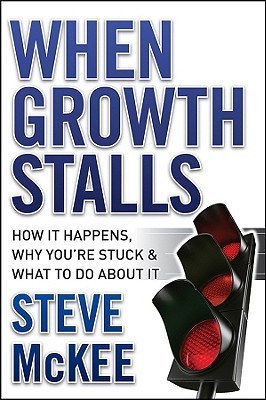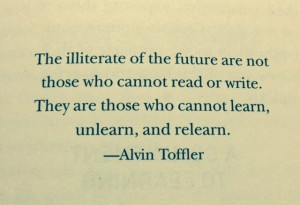
Your sales team was aligned and equipped to have a strong sales growth year. Your team created sales playbooks, buyer personas and new sales tools to insure you hit your sales goal (this time). Your team was building a strong momentum and then it feels like someone turned off the sales faucet. What just happened? What probably occurred is your team has experienced a market shift. How do you fix sales after a market shift? In this post I will share the strategy I have used when we experienced a market shift. ( and it’s not likely you are starting in the right place)
Before we discuss the strategy to refocus your sales efforts I want to remind you of a quote from my last post that shared various caused of market shifts. I used the below quote for years as a filter when asked to help companies in the middle of a market shift or more often after a market shift.
“Are you prepared to stake everything, change anything, and do whatever it takes— even if it means altering long familiar habits, redeveloping precious programs, and redeploying sacred assets?”
– Tom Bandy
A market shift will cause your company to change and adapt to the new reality. The degree of the shift and the severity of the shift’s impact on sales performance will determine just how much your team will need to adapt.
I can hear some skeptics saying …”We have been doing business this way for 15 years and we do not need to change, we need to wait until the market goes back to normal” The trouble is when your market shifts, you will never go back to normal.
Don’t believe me when I say how much markets change and shift? OK, how many people reading this have a Myspace account? From 2005 to 2008 Myspace was the most visited website in the United States, even more than Google! Today? Myspace is ranked 1272 on most visited website. What happened? A shift! New companies felt the shift and created products buyers wanted to buy.
Or listen to a leader who transformed shopping with Zappos.com.
“There’s a trans-formative shift in business, and what worked before is no longer an option. It’s time for evolved entrepreneurs, visionary creators, and change makers to rewrite the rules of business for the 21st century.”
Tony Hsieh, CEO of Zappos.com
Or read one of my past posts about when sales plans fail and how to adapt.
Do you agree markets shift ?
Assuming you are willing to adapt and change: “how we have always done things around here” in this post I will share the process I have used over the years to help sales teams fix sales problems due to a market shift.
Meet with your key customers who represented 80% of your sales opportunity before the shift. What you are looking for in these meetings is to clearly understand what shift occurred, when, and more importantly how your buyers plan to react to this shift. Having faced market shifts many times the first reaction for most sales teams is to target new customers. You may need to do this if your current market is not likely to produce sales to meet your sales goals. You must clearly understand what changed, how your buyers are and have reacted to that change.
Improve overall buying experience. Take the information you have gathered and update the way you deliver solutions to your market based on the way they want to buy and receive them.
Explore for technology shifts. Was the shift due to a technology shift? (72%) of business leaders think technology will transform their company’s competitive landscape in the coming years according to an IBM report .
While meeting with your key accounts ask if there are other departments within their organization that would value your team’s distinctive competence. Why? One of the reasons why buyers do not buy is risk. Can this new vendor execute what they are promising? Is their quality as good as they say? Will it be easy to work with them of difficult? The more a buyer feels there is risk the less likely they are to engage with a new vendor. The exception occurs when you are a:”vendor of record”. Your company is in their system. You are set up to receive purchase orders, get paid and so on. Assuming you have done a great job you can share your on time service statistics, your billing accuracy and have your other buyers refer you.
Based on meeting with your accounts you need to gather what you learned and create the following I shared In a post some time ago :
Write a market truths document based on gathered current data
Highlight strategies and tactics in your current sales plans that are no longer in alignment with the market of today
Asses your internal truths, capabilities, discard action items that do not support your objectives
If your team lacks a motivation to serve your market, create one
Determine your ideal customer profile
Write a plan you will execute based on the information you have gathered from the market and your capabilities. (allow some flexibility, design your sales plan to be Agile)
Once you complete the above you need to determine if making adjustments in your current markets with current customers will provide sufficient sales opportunity to achieve your sales goal. If yes proceed with executing your plan and you will not need the following steps.
After you have gathered your current market truths and internal truths and you determine your market does not have the opportunity necessary to achieve your sales goals please continue with this process and complete the following steps:
Find other accounts in the same market you have not sold yet. In most of the companies I have helped their “customers” have represented 20% to 30% of the entire market. In this step you will identify other accounts in the same market that are likely to have similar problems as the account(s) you have been selling. Keep in mind when business slows down buyers have time. They have time to meet with new vendors and they often have new goals like specific cost savings targets. When you discover this to be the case make sure the solutions you propose are shared in a way that speaks to the buyer’s company and personal goals.
Explore surrounding markets that include accounts buying products like those you supply. I look for adjacent markets that are interconnected to the markets I have been serving.
Expand your search for new markets that have similar problems your current market has. The key is to clearly understand your companies’ distinctive competence. What is your product or services’ value proposition? Is that value transferable into new markets? Ideally you want to find one to three accounts and test your assumption. In this process you will learn new information and a new language for the new market. Assuming your test clearly demonstrates value, you will want to scale that solution in the language of this new market.
Design new Innovate solutions if your current products no longer solve your current customer’s problems.
Share innovative new products in your current markets.
Share product innovations in adjunct markets
Share product innovations in new markets
As you lead your team through the above process you need to stop when a step will achieve your desired sales goals. For example, let’s say as you explored adjacent markets and you found a number of new accounts who agree with your value proposition, have agreed to buy your products and their sales will help you meet goal. Stop and execute. Stop following the steps and focus on executing in the adjacent market. Why? Why wouldn’t you have us do all of the above just to play it safe? Three reasons;
Focus – you want to lead your sales team with as clear a focus as possible. When you lack focus your team will be “very busy” but fail to achieve desired results.
ROI- The farther your team expands from your known core business the less RIO you will realize in the short term.
Timing – Often when sales teams experience a problem they have a short window to fix the sales problem. The farther you move from your core the longer it will take to win sales.
Have your sales taken a downward turn?
Did your sales team experience a recent market shift?
How does your sales team fix sales problems due to a market shift?
We serve dynamic markets and we need to expect them to change. When you experience a market shift the key to reacting and fixing your sales is clearly understanding the shift and having a systematic approach to finding new sales to insure your sales goals are still achieved. Most inexperienced sales managers will quickly launch into a new market. Why take this strategy that has a history of the slowest contribution, lower ROI per sales transaction and highest risk when a current market or a market close to your core will fix your sales problem? The above is the process I have used for years and I welcome comments on other processes and advice for when market shifts occur.












